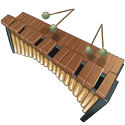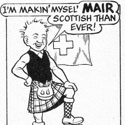|
Jason Sextro posted:I don't get this "mixed minor" thing. What I was taught in theory classes as a kid is that the traditional melodic minor was: major sixth, major seventh ascending, and then minor sixth and minor seventh descending. I'm not saying that Paganini is following this as a rigid formula, but I think melodic minor as specifically major sixth and seventh in both directions is a more recent thing. Hawkgirl posted:
the minor scale with a major sixth and major seventh in both directions is not dorian, rather its this thing https://en.wikipedia.org/wiki/Jazz_minor_scale natural minor scale has the flat 3, flat 6, and flat 7 (compared to the major scale) 1, 2, b3, 4, 5, b6, b7, 8 harmonic minor has the flat 3, flat 6, and natural 7 (compared to the major scale) 1, 2, b3, 4, 5, b6, 7, 8 dorian has the flat 3, the natural 6, and the flat 7 (compared to the major scale) 1, 2, b3, 4, 5, 6, b7, 8 jazz minor scale has the flat 3, natural 6, and natural 7 (compared to the major scale) 1, 2, b3, 4, 5, 6, 7, 8 if someone says "melodic minor" i take them to mean this thing ^^ regardless of the direction of melody. the ascending/descending distinction seems to be a strictly classical concept, i dont find it helpful Helianthus Annuus fucked around with this message at 04:35 on Feb 7, 2019 |
|
|
|

|
| # ? Jun 7, 2024 20:24 |
|
check out these chords in the natural minor and their friends from melodic minor Amin7 => Aminmaj7 Bm7b5 => Bmin7 Cmaj7 => Cmaj7#5 Dmin7 => D7 Emin7 => E7 Fmaj7 =>F#m7b5 G7 => G#m7b5 just look at all these altered 5ths. and the side-by-side dominants. yet look what happens to the one "weird" chord from the natural minor, the B half-diminished (Bm7b5). it becomes a normie Bmin7 chord, while everything around it grows horns and claws and fangs i sometimes think of the melodic minor like an extra bright dorian, or "harmonic" dorian (because it raises the b7 to a leading tone, like what happens when you turn natural minor into harmonic minor) but thats probably because i learned about dorian first... but i always say its because dorian and melodic minor have more tones in common than natural minor and melodic minor have Helianthus Annuus fucked around with this message at 04:15 on Feb 7, 2019 |
|
|
|
Hawkgirl posted:That's because classical pieces are just in minor; melodic and harmonic minor are called such because you would use them melodically or harmonically. So your melody will use, depending on the underlying chords and the direction it's going, one half of the melodic minor scale, whereas the chord progressions will stick to harmonic minor, specifically because that leading tone in the V chord makes it work so much better as a dominant. v is pretty rare in classical music, and even when used is almost always doing a double role in some sort of modulation situation (where it's like simultaneously v and like, ii or iv or vi or something in a new key) thx for that comment about the rarity of the minor v chord in classical music, thats good to know chords serving a double role in a modulation i call "pivot chords", wikipedia has this concept as "common chords" https://en.wikipedia.org/wiki/Common_chord_(music) i think i've linked to this video before, but its a good explanation of pivot chords imo https://www.youtube.com/watch?v=bPPqMnf91VY&t=284s Helianthus Annuus fucked around with this message at 04:43 on Feb 7, 2019 |
|
|
|
You're correct of course re: the jazz minor scale vs. dorian mode, thanks for pointing it out
|
|
|
|
Can anyone tell me the name of the image in the OP, generally? I have been trying to find any sort of academic source of that. I found some similarly drawn thing for the minor version on like scribbed, and a few other things floating around, but nothing that looks real or definitive. Or maybe its just an inside joke? No idea. I've tried googling around for various terms like "chord progression chart" or "chord resolution chart". Here is something similar, but they all seem sort of odd and wonky. Is there any place where this shows up academically? Or at least not in some cheezy amazon poster or a cocktail napkin?
|
|
|
|
|
Basic Poster posted:Can anyone tell me the name of the image in the OP, generally? I dunno what it's called exactly but it's definitely a real thing, seen it in a bunch of theory textbooks. I have both the major and minor versions of it (A "common practice harmonic progression chart" maybe?) taped to my wall above my practice area.
|
|
|
|
I've been doing some work on a app thing to display relationships between scales, intervals and the chords that can be built from them, and I thought it might be of interest to the thread. It's in a beta state at the moment at https://chordinatr.pigspigspigs.com/ The top table allows you to set your scale, by flattening or sharpening each degree (relative to the major scale), and shows you the intervals from and to each other degree of the scale. The bottom table shows the chords that can be built from each degree. You can click the cog in the top right to change the tonic, and to select quickly pick scales (i.e. ionic, pentatonic). I've never really seen anything that expresses the intervals within a scale in this way. I built it in order to easily see what chords could be built from 'exotic' scales, but also to see how the chords would change with the intervals within the scale. At the moment the functionality is there but there are some issues: - UI is very basic - Mobile view is broken - Chords are grouped weirdly - Can't change number of degrees without selecting a quick scale I would welcome any comments or suggestions! Any chord types that I have missed out on? Better ways of grouping chords than just sticking them in a big box labelled 'jazz'?
|
|
|
Gnumonic posted:I dunno what it's called exactly but it's definitely a real thing, seen it in a bunch of theory textbooks. I have both the major and minor versions of it (A "common practice harmonic progression chart" maybe?) taped to my wall above my practice area. Would you mind sharing a pic of it? I'm trying to integrate it into a larger quick ref chart I'm making.
|
|
|
|
|
Basic Poster posted:Would you mind sharing a pic of it? I'm trying to integrate it into a larger quick ref chart I'm making. Something like this?  From here: http://www.readmusicfree.com/ChordProgressionMap, but you can find a bunch of them with a search for 'chord progression map'.
|
|
|
Gruffalo Soldier posted:
|
|
|
|
|
Gruffalo Soldier posted:I've been doing some work on a app thing to display relationships between scales, intervals and the chords that can be built from them, and I thought it might be of interest to the thread. found a couple typos: aolian should be aeolian, and ionic should be ionian have you considered using lower-case roman numerals for minor chords, instead of always using upper case? it looks liek maybe sometimes you do, sometimes you dont. in places where its not appropriate to distinguish, might as well use arabic numerals and make it easier to read or maybe have the interval names abbreviated in the chart (m2, M2, m3, M3, P4, TT, P5, m6, M6, m7, M7, P8) is the fully diminished 7th missing from the chord list? that's spelled 1, b3, b5, bb7 e: is it easy to implement audio? i would love to hear each scale or chord when i click the associated element. Helianthus Annuus fucked around with this message at 20:24 on Feb 14, 2019 |
|
|
|
Helianthus Annuus posted:found a couple typos: aolian should be aeolian, and ionic should be ionian Helianthus Annuus posted:is the fully diminished 7th missing from the chord list? that's spelled 1, b3, b5, bb7 Helianthus Annuus posted:have you considered using lower-case roman numerals for minor chords, instead of always using upper case? it looks liek maybe sometimes you do, sometimes you dont. in places where its not appropriate to distinguish, might as well use arabic numerals and make it easier to read Helianthus Annuus posted:e: is it easy to implement audio? i would love to hear each scale or chord when i click the associated element. Thank you for the feedback!
|
|
|
|
right on, can we get some octotonic / bebop scales in here? how about major 6th and minor 6th chords? in particular, i'm interested in what Barry Harris calls the "major 6th diminished scale", which is equivalent to https://en.wikipedia.org/wiki/Bebop_scale#Bebop_major_scale warning: he is extremely long winded lol https://www.youtube.com/watch?v=F8JJncSUdUU the Major 6th Diminished Scale is one of the 4 scales Barry talks about. Barry thinks of these scales as a combination of notes from two complimentary chords. One of those chords is always the fully diminished chord. The other is one of these four different kinds of jazz chord, which gives the scale its name. Major 6th Diminished Scale: C D E F G Ab A B C6: C E G A Bdim7: B D F Ab Minor 6th Diminished Scale: C D Eb F G Ab A B Cm6: C Eb G A Bdim7: B D F Ab Seventh Diminished Scale: C D E F G Ab Bb B C7: C E G Bb Bdim7: B D F Ab Seventh Flat 5 Diminished Scale: C D E F Gb Ab Bb B C7b5: C E Gb Bb Bdim7: B D F Ab This is something Barry does on piano, but I'm just a guitarist, so it's hard for me to internalize and apply on my instrument. It seems like a radically different way to think about harmony vs what you learn in The Jazz Theory Book by Mark Levine Right now I'm working thru Alan Kingstone's book: The Barry Harris Harmonic Method for Guitar right now, and thats where I copy-pasted the above from.
|
|
|
|
Gruffalo Soldier posted:Audio is on my todo list. Making the sounds play is easy enough, I need to put some thought into the interface, and what to do the case some of the more complex chords where there is an octave between the intervals. A 9 chord should be played I, III, V, VII, II rather than I, II, III, V, VII, for example. A small correction, just in case this is in the app anywhere (I haven't had time to check): while chords use Roman numerals (I, ii, IV, etc.), their constituent tones use Arabic numerals (1 3 5, 1 4 5, etc.)
|
|
|
|
Jazz Marimba posted:A small correction, just in case this is in the app anywhere (I haven't had time to check): while chords use Roman numerals (I, ii, IV, etc.), their constituent tones use Arabic numerals (1 3 5, 1 4 5, etc.) Noted, cheers. Helianthus Annuus posted:right on, can we get some octotonic / bebop scales in here? how about major 6th and minor 6th chords? I've added the 6 / m6 chords in. I've also added the 4 scales you suggested to the 'quick scales' drop-down in the settings menu. For even more scale weirdness you can now add / remove degrees as you like in the settings, to build scales with 3 - 12 degrees. The interface for this is a bit rubbish, but it should do the trick for now.
|
|
|
|
can you make it highlight chords that are inversions of eachother? one chord is an inversion of another if both are spelled with the same tones but in a different order. e.g., in C major 6 diminished scale, when I hover on Am7, I want to be shown that C6 is an inversion of that chord. e.g., in C major 6 diminished scale, when i hover on B fully diminished, i want to be shown that the D, F, and Ab fully diminished chords are all inversions of the B chord.
|
|
|
|
got a regression for you too: when i go to change the tonic, i should be able to use backspace on my keyboard to clear the current tonic. i shouldn't have to highlight the current tonic to replace it. this could probably just be a dropdown
|
|
|
|
Helianthus Annuus posted:can you make it highlight chords that are inversions of eachother? one chord is an inversion of another if both are spelled with the same tones but in a different order. Ooh that's a good one. I'll have a think about how to implement it. Helianthus Annuus posted:got a regression for you too: when i go to change the tonic, i should be able to use backspace on my keyboard to clear the current tonic. i shouldn't have to highlight the current tonic to replace it. this could probably just be a dropdown Should be fixed in the latest release.
|
|
|
|
Audio is now in! You can play the current scale by clicking the icon at the top left of the top table, and if you hover over an interval (top table), or a chord (bottom table) you can play them in varying ways. Also now when you hover over a chord, it's inversions will be highlighted in yellow.
|
|
|
|
this thing is dope! being able to hear the chords is killer. personal taste: i'd speed up the arpeggios and scales a bit found a bug with the inversion highlighting feature. in the Major 6th Diminished Scale, the fully diminished chords should all be inversions of eachother, but thats not showing up. when i hover over them, each chord is spelled a little differently, Ebb vs D for example also sometimes it will highlight a chord that isn't an inversion. for example, in the Major 6th Diminished Scale, its saying Dm6 is an inversion of the D diminished triad, which isn't the case but that last bug got me thinking... we have now a visual indication of chords which share all the same tones (inversions). how about a different color for chords which share common tones but with one difference? and yet another color for chords which share common tones, but with two differences, and so on. this might get visually too "busy" on the page, but the idea here is to show chords which are good candidates for voice leading or substitution.
|
|
|
|
Helianthus Annuus posted:this thing is dope! being able to hear the chords is killer. personal taste: i'd speed up the arpeggios and scales a bit Thanks, it is shaping up nicely! Your feedback and suggestions are really useful  I've updated it so that a 'full inversion' (i.e. all notes the same) will highlight green, chords with one note different will be dark blue and two notes different will be light blue. It seems to be working!
|
|
|
|
discovered something new to me clicking around on this thing. Csus2 is an inversion of Gsus4. it makes sense, and it's not surprising, but its not something i ever thought of before here's a UX suggestion. the new highlighting feature tells me about chords that are only different by one or two tones. but trying to figure out which tones are different is kind of awkward right now. i find myself hovering over one chord, looking at the top pane to see which tones are in it, committing those to memory, then hovering over another chord and comparing what i see with what i remember from the first chord maybe clicking a chord could cause it to stay focused. and when i go to hover over another chord, it could show the tones from both chords, maybe with slightly different colors to differentiate the chord i clicked on vs the chord i'm just hovering over
|
|
|
|
a more sophisticated approach would be to use different hues to indicate when the "other" chord has a different root, altered 3rd, altered 5th, altered 7th, or some combination but im having a hard time putting that in concrete terms for you, so i can't even be sure that this approach makes sense
|
|
|
|
Helianthus Annuus posted:discovered something new to me clicking around on this thing. Csus2 is an inversion of Gsus4. it makes sense, and it's not surprising, but its not something i ever thought of before I agree, the 'chord explorer' section of the app seems to be becoming much more important than the scale section as it develops. I think the ui in general needs a little thought in order to reflect this. I'll have a play around with it.
|
|
|
|
Ok, a fairly big update. I've tried to make the chord explorer and highlighting more useful. UI is a bit all over the place but I want to nail down the logic and functionality before I polish it. Clicking chords will now set them as 'active' in the left and right at the bottom of the screen. When one chord is active, the others will highlight depending on their similarity - notes in common, notes added, notes removed. The stronger the colour, the closer the chords. When two chords are active, the others will highlight depending on how close they are to *both* active chords. This is mainly where I need to get the logic sorted out. My brain is a bit frazzled so I have pushed the changes and will sleep on them. Any thoughts on how to define similarity of chords is appreciated! https://chordinatr.pigspigspigs.com/
|
|
|
|
Another spelling oopsie: Phyrgian should be Phrygian  I like this a lot! I've always used http://www.looknohands.com/chordhouse/piano/ before, but since it's from the really old days before web APIs its note playback functionality refuses to work.
|
|
|
|
Laserjet 4P posted:Another spelling oopsie: Phyrgian should be Phrygian Fixed, cheers.
|
|
|
|
couldn't think of any feature requests, but i found a bug i was able to get it to reliably crash by selecting the Major 6th Diminished Scale and closing/opening the chord "folders" heres the stack from chrome's console code:
|
|
|
|
Is it a reasonable question to ask "How exactly are chords constructed" with examples? Obviously there must be a systematic nature to it, but it's unclear to me. I'm in a guitar for dummies course and we were given a finger guide for chords, and identifying and writing them out is on our test. I was hoping just to determine what determines their make-up so I could build them as needed, but every example I could find doesn't actually use standard notation, just finger positions...Or they talk way over my head. I just wanted to learn how to build major/minor/Dominant 7th!
|
|
|
|
Chords are really just multiple notes simultaneously. Most Western music is built on tertian harmony, which is chords built on thirds. You start from the root, add either a major or a minor third, and then a major/minor third on top of that, which works out to: -Root -Third -Fifth At this point, it helps immensely to have a rock-solid grasp of intervals. The qualities of the third and the fifth will determine the chord quality; Root (1) major third (+3) and perfect fifth (P5) make a major chord. Root (1) minor third (-3) and perfect fifth (P5) make a minor chord. Root (1) minor third (-3) and a diminished fifth (-5) will give you a diminished chord. Root (1) major third (+3) and an augmented fifth (+5) make an augmented chord. A seventh chord is one of these triads plus a seventh, which is another third (up from the fifth). Root (1), major third (+3) perfect fifth (P5) and a major seventh (+7) make a major seventh chord; notated as maj7, M7, or (triangle)7. Root (1), major third (+3) perfect fifth (P5) and a minor seventh (-7) is the dominant seventh, which is always just 7. Root (1), minor third (-3), perfect fifth (P5) and minor seventh (-7) is the minor seventh chord, seen as m7 or -7 if you have a lot of Berklee Press books. Root (1), minor third (-3), diminished fifth (-5) and a minor seventh (-7) is a half-diminished chord; either m7b5 or (circle-with-slash-through-it)7. Root (1), minor third (-3), diminished fifth (-5) and diminished seventh (or one semitone down from a minor seventh) is the diminished seventh, seen all over Yngwie Malmsteen songs for 35 years and counting. Usually notated as either o7 or dim7. Finally, as far as standard sevenths, you have a couple of unusual outliers; Root (1), minor third (-3), perfect fifth (P5) and a major seventh (+7) is the minor/major seventh, something like mM7, m/maj7, etc. Root (1), major third (+3), augmented fifth (+5) and a major seventh (+7) gives you the M7+, or maj7#5, something in that vein. This is just a basic foundation, we're not even getting into extensions or altered tones with this, let alone clusters or quartals for that matter.
|
|
|
|
that’s a good post, i want to supplement it with a visual explanation of the same thing https://www.musictheory.net/lessons/46 aside from knowing which intervals spell which chords, this also explains how the major scale organizes a group of chords that sound good together if you play Am D G on your guitar, your ear will tell you there’s something about these chords that makes them sound good together. it’s because they all come from the G Major scale. in other words, they are all “diatonic” to the key of G major
|
|
|
|
it helps to have a way of identifying the intervals in a chord you already know how to play for example, starting from any note on the thickest string: a perfect 4th is found directly underneath your starting note a major 3rd is directly behind that. in other words, on the next string, one fret back a perfect 5th is on the next string, two frets forward from your starting note and you have an octave from your starting note directly underneath that perfect 5th this link has pictures and explanations to make it easier to actually see what i’m talking about http://www.fretjam.com/guitar-intervals.html
|
|
|
|
so with that in mind, you can see that an open E major chord has the perfect 5th as it’s first interval, and the open G major chord has a major 3rd the takeaway here is that you can mix up the intervals and still have the same kind of chord. we call these different “voicings” of the same chord
|
|
|
|
Two questions: 1) Does anyone have a good reference for musical form? I'm asking because it's dawned on me over the past month or so that I really don't want to write verse/chorus style songs. I want to write instrumental music, and having something like sonata form in mind helps me organize ideas in a more natural way than ABAB or whatever. But sonatas are kind of laborious to write and I'd like to explore other organizational structures for instrumental pieces. 2) Anyone have a good reference on modulation? I mean I know what it is, but it'd be nice to see a bunch of examples of how to get from one key to another key. Something that gives me contemporary style chord names and not figured loving bass (fuuuuccckkk figured bass) is vastly preferable. My music theory tbook only uses figured bass for the examples and I hate it and cannot deal with it.
|
|
|
|
this might be the third time ive posted this video itt, but i think it can help with understanding modulation https://www.youtube.com/watch?v=bPPqMnf91VY i don't have a lot of resources for song forms, maybe someone else knows something
|
|
|
|
i'm trying to learn more about jazz chords and i was wondering if there's a good resource on chord substitution or implementation? like, i can comp any tune fairly well with the standard progressions, but how do you know when and where to put in a diminished or augmented or whatever chord?
|
|
|
|
Coohoolin posted:i'm trying to learn more about jazz chords and i was wondering if there's a good resource on chord substitution or implementation? like, i can comp any tune fairly well with the standard progressions, but how do you know when and where to put in a diminished or augmented or whatever chord? its a pretty broad topic, can you please ask your question in more concrete terms? also, what instrument? i can tell you about tritone substitution and secondary dominant chords if you want. are you using inversions to make the changes with smooth voice leading? If you're looking for something more advanced than that, Barry Harris probably knows best what to do with diminished chords https://www.youtube.com/watch?v=F8JJncSUdUU he talks (in religious terms) about these symmetrical structures in 12 tone equal temperament. i want to point them out concretely before you go into that video, because you've asked about two of them, and because it's hard to understand wtf barry is talking about sometimes. the symmetrical structures are: * the 2 unique whole tone scales (6 notes each) * the 3 unique fully diminished 7th chords (4 notes each) * the 4 unique augmented triads (3 notes each) * the 6 unique tritone intervals (2 notes each) regarding how to apply these concepts? sometimes the lead sheet will explicitly call for a diminished chord or an augmented chord. other times it will called for an altered dominant 7th, which is another opportunity to play a flat 5 or a sharp 5. but it's usually not safe to play a chord with an altered 5th when its not called for. rather than just using them in substitutions, you can also use diminished chords as passing chords between the ones called for on your lead sheet. you don't necessarily have to play the full chords, just playing a couple diminished notes on your way from here to there. this adds the feeling of motion to your playing, and it lets you use voice leading to connect chords one thing barry will point out in that video: take a fully diminished 7th chord, then lower one of the tones. this gives you a dominant 7th chord. try it for each tone in the fully diminished 7th chord, you should be able to make four different dominant 7th chords. likewise, if you raise a tone from the fully diminished 7th chord, you get a m7b5 (aka half-diminished) chord. again, there are four of them you can get to from a single fully diminished 7th chord. this is probably the most practical application I can get from this, because you can plug that movement right into your playing to get some more motion whenever you are dealing with dominant chords im hoping a more skilled jazz improviser can reply to you, because i feel like i haven't answered you satisfactorily
|
|
|
|
e: this isnt really related to the other posts about barry harris and diminished chords. just something else thats been on my mind hey check this out He explains the mathematical origins of music. Octaves come from the powers of 2. The powers of 3 give you perfect fifths (actually compound perfect 5ths aka perfect 12ths). And from there he shows how you can introduce a "comma" (treating an approximation in pitch as an equality) to close the system formed by the powers of 2 and 3, and thereby derive the 12 tone system. Then he extends this concept of a "comma" to mean "introducing an approximation to close the system prematurely", and then derives the pentatonic scale and major scale from the 12 tone system. He calls this "prime generation in a closed system" https://www.youtube.com/watch?v=sItSHfYG3oY looks like its written up here http://mtosmt.org/issues/mto.16.22.2/mto.16.22.2.cohn.html One cool thing he said at 22:25 about prime generation in a closed system: it gives you cool african rhythms that are somehow isomorphic to the western major scale quote:[8.9] Pressing’s work invites us to view 3-generated funky and 2-generated Balkan rhythms as specific instances of a more general phenomenon: the interaction of any prime numbers, in any multiplicity. These include the “diatonic” rhythms of the so-called “standard” bell pattern of sub-Saharan drumming ensembles, which 5-generate against a cycle of 22 × 3 = 12 units, and the hyperdiatonic rhythms of much African-diasporic music, which 7-generate against a pure duple cycle of 16 units, for example the rotationally related ostinati that underlie two classics of late-1960s rock: Cream’s “Sunshine of Your Love”, and Iron Butterfly’s “In-a-gadda-da-vida.” Helianthus Annuus fucked around with this message at 06:40 on Apr 3, 2019 |
|
|
|
Coohoolin posted:i'm trying to learn more about jazz chords and i was wondering if there's a good resource on chord substitution or implementation? like, i can comp any tune fairly well with the standard progressions, but how do you know when and where to put in a diminished or augmented or whatever chord? Helianthus Annuus posted:you can also use diminished chords as passing chords between the ones called for on your lead sheet. you don't necessarily have to play the full chords, just playing a couple diminished notes on your way from here to there. this adds the feeling of motion to your playing, and it lets you use voice leading to connect chords needed to expand on this a bit when you're playing in a key, there's a specific diminished 7th chord that lives in that key. in the key of c, that's Bdim7 (B D F G#) and its inversions. so you're leaving the other two fully diminished 7th chords, Cdim7 and C#dim7 and (their inversions). So in the key of C major, B D F G# are "the diminished notes" i was talking about B D F G# are also "the diminished notes" of the following keys C major Eb major Gb major A major barry calls the relationship between these keys "brothers and sisters" but those notes also form the Cdim7 chord (C Eb Gb A), isnt that cool? what blows me away about this is that other concepts of harmony don't consider the keys of C major, Eb major, Gb major, and A major to be related. but they are related by their common diminished chord. so among other things, you can use the diminished chord to modulate smoothly between these 4 keys
|
|
|
|

|
| # ? Jun 7, 2024 20:24 |
|
Coohoolin posted:i'm trying to learn more about jazz chords and i was wondering if there's a good resource on chord substitution or implementation? like, i can comp any tune fairly well with the standard progressions, but how do you know when and where to put in a diminished or augmented or whatever chord? This is all according to Berklee's very excellent jazz harmony book: in standard functional harmony, best practices around diminished chords depend on what kind of diminished seventh it is. #Io7 and Io7 are very different, for example. On the one hand, #Io7, #IIo7 and #Vo7 are often used as passing chords; #Io7 shows up between Imaj7 and II-7, #IIo7 between II-7 and III-7, and #Vo7 between V7 and VI-7. But there are also cases where #IIo7 and #IVo7 are used as leading back to inversions of the tonic - #IIo7 leads to the first inversion and #IVo7 to the second inversion. #IIo7 and #Vo7 also act as bIIIo7 and bVIo7 as passing chords moving downwards into III-7 and some form of V7 or V-7; Jobim's wave starts on a very unusual Imaj7/VIo7/V-7. One of the other major ways diminished chords are used are as auxiliary embellishments; if you have several measures of a Imaj7, you can embellish that with an alternation between Imaj7 and Io7. The same applies for V7; if you want to draw that out to elevate the sense of tension you can alternate between V7 and Vo7. I'm not sure I got everything, but this all hasn't yet been mentioned from what I can see, so I hope it's useful!
|
|
|




 I mean you’re correct, but also I dunno where you’re coming from. Melodic minor is still the traditional one you’re familiar with btw, the thing you’re talking about at the end of your post is a mode called Dorian
I mean you’re correct, but also I dunno where you’re coming from. Melodic minor is still the traditional one you’re familiar with btw, the thing you’re talking about at the end of your post is a mode called Dorian








